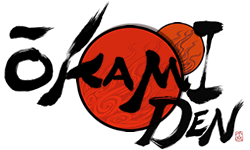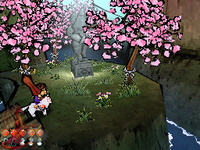|
|

|
PLATFORM
|
DS
|
BATTLE SYSTEM
|

|
INTERACTION
|

|
ORIGINALITY
|

|
STORY
|

|
MUSIC & SOUND
|

|
VISUALS
|

|
CHALLENGE
|
Very Easy
|
COMPLETION TIME
|
20-40 Hours
|
|
OVERALL

|
+ Great boss battles.
+ Fantastic visuals and soundtrack.
+ Absolutely adorable.
- Fidgety camera.
- Too easy.
- Recycled boss fights at the end of the game.
|
Click here for scoring definitions
|
|
|
When Okami was released in 2006 on the PS2, it quickly became a sleeper hit, enough so that it was rereleased in early 2008 for the Wii with a new control scheme. Unfortunately, the game still wasn't successful enough to keep its developer, Clover Studios, in business, and the company folded soon after. Hope for a sequel was all but lost, but thankfully, the license was passed on to the game's publisher, Capcom, and it wasn't long before they announced Okamiden, a sequel for the Nintendo DS.
Although Okamiden takes place nine months after the events of Okami and is, in all respects, a proper sequel to the game, it would simultaneously be more accurate to compare it to the post-series anime specials where all the characters have been made ridiculously adorable. Where Okami was epic in scope and breathtaking to behold, Okamiden may very well be the cutest damned game in existence. Even without the endearing puppy antics of Chibiterasu, Amaterasu's son and Okamiden's protagonist, nearly every character in the game oozes charm from every pixel.
Okamiden begins with Chibiterasu meeting up with Issun, Okami's miniature sidekick character, at which point it becomes apparent that evil is once again spreading across Nippon. However, Issun is preoccupied with his own duties, so Chibiterasu (also known as Mutt, Pooch, Squiddy, and Pork Chop) has to find a new partner to team up with. It's not long before he encounters Kuni, the son of the "warrior" Susano, and the pair team up to save Nippon from evil.
Like Okami, Okamiden's story is quite strong, and the localization in particular is top notch, despite surprisingly regular typos. Okamiden's is a character-focused story, and in addition to Kuni and Issun, Chibi encounters five other characters who become his partner at one time or another. Each one also gives Chibi a special nickname, and this becomes one of the game's more amusing running gags. Each character has a unique personality, and since each one acts as Chibi's voice during their time together, a new viewpoint on the world comes with each swap. For those who haven't played the original Okami, Okamiden's tale is also fairly self-contained, and the limited knowledge needed from the first game is quickly supplied whenever necessary.
 The son of the sun goddess makes the sun rise.
The son of the sun goddess makes the sun rise.
|
|
It shouldn't surprise anyone familiar with the original title that Okamiden's gameplay bears a striking resemblance to The Legend of Zelda. What may surprise people, however, is that where Okami played off of the 3D Zelda titles like Wind Waker and Twilight Princess, Okamiden bears a striking resemblance to the recent DS Zelda games, Phantom Hourglass and Spirit Tracks. Most dungeons make use of fixed cameras (though there's still a free, chase-camera in place in areas such as the world map), and the puzzles in the game, though much simpler than the ones in the Zelda titles, make use of similar mechanics. Most notably, Chibi's partner can be dropped off and guided separately from Chibi, allowing them to solve puzzles in tandem.
This guiding technique, and in fact all of Chibi's techniques, make use of the Celestial Brush skills that made the original Okami so popular. By drawing special symbols or context-sensitive lines on the touch screens, Chibi can manipulate his environment and attack enemies in a wide variety of ways. Normal enemies and especially bosses all make themselves vulnerable to different brush skills at various points in their combat styles, which makes combat more of a puzzle than a battle. Most of the brush skills in Okamiden are taken directly from Okami, but a handful of new ones, such as the aforementioned guide skill, a magnetism skill, and others, provide some interesting new situations. As one might expect, the brush skill mechanic translates brilliantly to the DS, and in fact works far better than it ever did in the original.
Unfortunately, Okamiden does hit a few snags, mostly due to the console-oriented nature of its original gameplay. The camera is often quite frustrating, particularly in open areas and in regular battles. Because the L and R buttons are used to activate the Celestial Brush mode, camera control has to be relegated to small arrows on either side of the touch screen, which can be used in conjunction with the fairly decent, but still fidgety chase camera. Although it's a surprisingly creative and elegant solution to the problem of camera control, it's still quite awkward. The game also falls into the same pitfall that Okami did towards the end of the game, having you fight several old bosses a second time. More than anything, though, Okamiden suffers from being too easy on all levels. The puzzles aren't very challenging, nor are any of the fights, even though the bosses are extremely engaging and quite enjoyable in their own right. Healing items are cheap and can be purchased in large quantities, which seems diametrically opposed to a combat system where forecasting and avoiding attacks is the primary goal and challenge. Despite this, it's still a lot of fun thanks to engaging mechanics.
 Pretty flowers.
Pretty flowers.
|
|
Luckily, Okamiden succeeds in other areas. The visuals, in addition to being adorable and endearing, are also some of the highest quality 3D you'll find on the DS. The cel-shading in place is absolutely phenomenal, and while the game doesn't sport the same washed-out feel as the original Okami, the crispness of the models and the impeccable animation make the game a treat for the eyes. The color palette is extremely bright, which helps to make the model outlines more distinct. Unfortunately, this kind of visual fidelity comes at a price, and in this case it's the draw distance. While basic environment geometry — hills, walls, etc. — isn't affected, foreground objects have a tendency to simply pop into existence as you approach. Trees, rocks, and even enemies only appear when Chibi is only a few paces away from them, which becomes quite distracting and can easily catch a player by surprise. Thankfully, this only affects areas with a free camera.
Like its visuals, Okamiden's soundtrack is also fantastic. The music has the Japanese folk style that was seen in the original title, and there isn't a bad piece in the mix. The soundtrack is quite large, and when the game is completed, most if not all of the tracks become available to listen to in the menu. The game also sports many of the same sound effects that defined Okami, including the warbling speech and the iconic "bloom" sound.
Fans of the original Okami may be a bit disappointed by Okamiden. While the game is quite enjoyable in its own right, it had a rather big name to live up to, and it simply isn't as good as Okami. Despite that, Okami fans should still give Okamiden a shot, as it still has all the things that made the original so terrific. With a more balanced difficulty and stronger puzzle designs, Okamiden probably would have been able to beat The Legend of Zelda at its own game, but for now, Chibiterasu will have to settle for simply being on even ground with Link.
Review Archives
|









